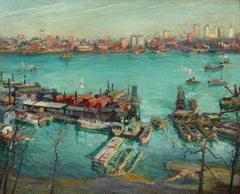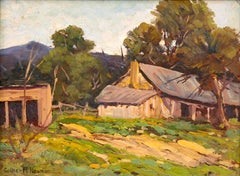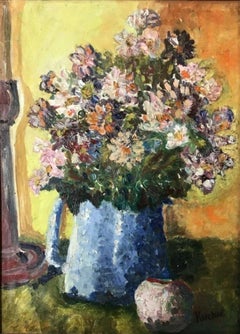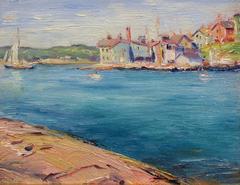Max Kuehne Paintings
American, 1880-1968
Born in Halle, Germany in 1880, Max Kuehne was a colorist who created cheerful landscapes that appear to be painted spontaneously and with freshness.
He studied with William Merritt Chase and Kenneth Hayes at the Chase School in New York. In 1910, he embarked on a bicycling trip, traveling through England, France, Germany, Holland and Belgium. To support this trip he did portrait commissions along the way.
When he returned to New York City, he set up a studio in Greenwich Village and was a student of Robert Henri from whom he learned a dark impressionist style. He also became close with such avant garde artists as Guy Pene du Bois, William Glackens, William Zorach and Maurice and Charles Prendergast, which also influenced his dark work including street scenes and docks in New York City. However, three years in Spain, and painting trips to Gloucester lightened his palette as did time in Paris where he was much influenced by the Fauves, Nabis, and decorative painters. By 1912 he was producing work that would make him known as a "colourist of great distinction" by producing "paintings full of sparkling sunlight."
He became a member of the artistic community later in Rockport, Massachusetts, with Gifford Beal, Leon Kroll, Paul Manship, Edward Hopper and Jonas Lie. Many of his finest paintings done later in his career are of the busy harbors and piers of Gloucester and Rockport.
His work was widely exhibited including the National Academy of Design, the Art Institute of Chicago, and the Carnegie Institute in Pittsburgh.(Biography provided by Helicline Fine Art)
to
1
3
3
3
2
1
Overall Height
to
Overall Width
to
2
1
1
1
1
3
1
1
5
916
660
657
610
3
2
1
1
1
Artist: Max Kuehne
New York Skyline
By Max Kuehne
Located in New York, NY
Max Kuehne paints a dockyard across the river from the skyscrapers of New York City in his artwork entitled, “New York Skyline”
Category
1920s Max Kuehne Paintings
Materials
Canvas, Oil
"Train Station, " Max Kuehne, Industrial City Scene, American Impressionism
By Max Kuehne
Located in New York, NY
Max Kuehne (1880 - 1968)
Train Station, circa 1910
Watercolor on paper
8 1/4 x 10 1/4 inches
Signed lower right
Provenance:
Private Collection, Illinois
Max Kuehne was born in Halle, Germany on November 7, 1880. During his adolescence the family immigrated to America and settled in Flushing, New York. As a young man, Max was active in rowing events, bicycle racing, swimming and sailing. After experimenting with various occupations, Kuehne decided to study art, which led him to William Merritt Chase's famous school in New York; he was trained by Chase himself, then by Kenneth Hayes Miller. Chase was at the peak of his career, and his portraits were especially in demand. Kuehne would have profited from Chase's invaluable lessons in technique, as well as his inspirational personality. Miller, only four years older than Kuehne, was another of the many artists to benefit from Chase's teachings. Even though Miller still would have been under the spell of Chase upon Kuehne's arrival, he was already experimenting with an aestheticism that went beyond Chase's realism and virtuosity of the brush. Later Miller developed a style dependent upon volumetric figures that recall Italian Renaissance prototypes.
Kuehne moved from Miller to Robert Henri in 1909. Rockwell Kent, who also studied under Chase, Miller, and Henri, expressed what he felt were their respective contributions: "As Chase had taught us to use our eyes, and Henri to enlist our hearts, Miller called on us to use our heads." (Rockwell Kent, It's Me O Lord: The Autobiography of Rockwell Kent. New York: Dodd, Mead and Co., 1955, p. 83). Henri prompted Kuehne to search out the unvarnished realities of urban living; a notable portion of Henri's stylistic formula was incorporated into his work.
Having received such a thorough foundation in art, Kuehne spent a year in Europe's major art museums to study techniques of the old masters. His son Richard named Ernest Lawson as one of Max Kuehne's European traveling companions. In 1911 Kuehne moved to New York where he maintained a studio and painted everyday scenes around him, using the rather Manet-like, dark palette of Henri.
A trip to Gloucester during the following summer engendered a brighter palette. In the words of Gallatin (1924, p. 60), during that summer Kuehne "executed some of his most successful pictures, paintings full of sunlight . . . revealing the fact that he was becoming a colorist of considerable distinction." Kuehne was away in England the year of the Armory Show (1913), where he worked on powerful, painterly seascapes on the rocky shores of Cornwall. Possibly inspired by Henri - who had discovered Madrid in 1900 then took classes there in 1906, 1908 and 1912 - Kuehne visited Spain in 1914; in all, he would spend three years there, maintaining a studio in Granada. He developed his own impressionism and a greater simplicity while in Spain, under the influence of the brilliant Mediterranean light. George Bellows convinced Kuehne to spend the summer of 1919 in Rockport, Maine (near Camden). The influence of Bellows was more than casual; he would have intensified Kuehne's commitment to paint life "in the raw" around him.
After another brief trip to Spain in 1920, Kuehne went to the other Rockport (Cape Ann, Massachusetts) where he was accepted as a member of the vigorous art colony, spearheaded by Aldro T. Hibbard. Rockport's picturesque ambiance fulfilled the needs of an artist-sailor: as a writer in the Gloucester Daily Times explained, "Max Kuehne came to Rockport to paint, but he stayed to sail." The 1920s was a boom decade for Cape Ann, as it was for the rest of the nation. Kuehne's studio in Rockport was formerly occupied by Jonas Lie.
Kuehne spent the summer of 1923 in Paris, where in July, André Breton started a brawl as the curtain went up on a play by his rival Tristan Tzara; the event signified the demise of the Dada movement. Kuehne could not relate to this avant-garde art but was apparently influenced by more traditional painters — the Fauves, Nabis, and painters such as Bonnard. Gallatin perceived a looser handling and more brilliant color in the pictures Kuehne brought back to the States in the fall. In 1926, Kuehne won the First Honorable Mention at the Carnegie Institute, and he re-exhibited there, for example, in 1937 (Before the Wind). Besides painting, Kuehne did sculpture, decorative screens, and furniture work with carved and gilded molding. In addition, he designed and carved his own frames, and John Taylor Adams encouraged Kuehne to execute etchings. Through his talents in all these media he was able to survive the Depression, and during the 1940s and 1950s these activities almost eclipsed his easel painting. In later years, Kuehne's landscapes and still-lifes show the influence of Cézanne and Bonnard, and his style changed radically.
Max Kuehne died in 1968. He exhibited his work at the National Academy of Design, the Art Institute of Chicago, the Carnegie Institute in Pittsburgh, the Memorial Art Gallery of the University of Rochester, and in various New York City galleries. Kuehne's works are in the following public collections: the Detroit Institute of Arts (Marine Headland), the Whitney Museum (Diamond Hill...
Category
1910s American Impressionist Max Kuehne Paintings
Materials
Paper, Watercolor
Provincetown
By Max Kuehne
Located in Milford, NH
A colorful impressionist coastal oil painting of Provincetown by German / American artist Max Kuehne (1880-1968). Kuehne was born in Halle, Germany, and emigrated to Flushing, New Y...
Category
Mid-20th Century American Impressionist Max Kuehne Paintings
Materials
Panel, Oil
Related Items
Mid Century River Birches Landscape Watercolor
Located in Soquel, CA
Mid Century River Birches Landscape Watercolor
Gorgeous vibrant mid century watercolor on paper painting of river birch trees by artist Eva Collins Marks (American, 20th century),19...
Category
1950s American Impressionist Max Kuehne Paintings
Materials
Watercolor, Paper
Old House, Built in 1848
By Gilbert Neumann
Located in Austin, TX
"Old House, Built in 1848" by painter Gilbert F. Neumann
Medium: Oil paint on panel
Size: 9 x 12 inches
Frame Size: 14 x 18.5 inches
A nostalgic painting of ...
Category
20th Century American Impressionist Max Kuehne Paintings
Materials
Panel, Oil
Boats docked in the water
Located in VÉNISSIEUX, FR
I enjoy working on semi-abstract artworks with a touch of impressionism.
This is the one of the artworks which was inspired by the beauty of the south of France. I was inspired by ...
Category
2010s American Impressionist Max Kuehne Paintings
Materials
Paper, Acrylic
Mountain Ranch, Modern Summer Colorado Mountain Landscape, Watercolor Painting
By Irene D. Fowler
Located in Denver, CO
Original signed watercolor painting of a ranch in the Colorado mountains in springtime or summer coloring of green, blue, yellow, white and brown by Denver artist, Irene Fowler. Presented in a custom frame with all archival materials, outer dimensions measure 17 ½ x 23 ½ x 1 ½ inches. Image size is 12 x 18 inches.
About the Artist:
An important figure in the development of Denver as an artistic city, Irene Fowler was a public school teacher and founding member of the Denver Artist’s Guild (now the Colorado Artist’s Guild) in addition to being a prolific artist.
She exhibited in Denver at the Schlier Gallery (where she had a solo exhibition), at the Chappell House, the University Club, and the Broadmoor Art Gallery in Colorado Springs. In 1950-1952 she served as president of the Denver Artist’s Guild.
Fowler painted in oil or watercolor and her paintings were almost exclusively done en plein air. Her landscapes of Colorado...
Category
Mid-20th Century American Impressionist Max Kuehne Paintings
Materials
Watercolor
H 17.5 in W 23.5 in D 1.5 in
Mid Century California Mission Landscape
Located in Soquel, CA
Beautiful mid century landscape of a historic California mission, highlighting its iconic architectural details such as a columned arches, white was...
Category
Mid-20th Century American Impressionist Max Kuehne Paintings
Materials
Gouache, Cardboard, Paper
Bali Landscape
Located in Columbia, MO
Benjamin Cameron spent 48 years teaching students in Columbia across three different colleges. His own works still hang on the walls around the community and tell a greater story of ...
Category
21st Century and Contemporary American Impressionist Max Kuehne Paintings
Materials
Watercolor, Archival Paper
Sea cliff
Located in VÉNISSIEUX, FR
I enjoy working on semi-abstract artworks with a touch of impressionism.
This is the one of the artworks which was inspired by the beauty of the south of France and in particularly,...
Category
2010s American Impressionist Max Kuehne Paintings
Materials
Acrylic, Paper
Pt. Pinos California, Coastal Figural Landscape Watercolor
By Donald J. Phillips
Located in Soquel, CA
Pt. Pinos California, Coastal Figural Landscape Watercolor
Striking depiction of a lighthouse by Donald J. Phillips (American, 20th Century). Signed and dated "DONALD J. PHILLIPS WW/7-89" in the lower right corner. Tag on verso with artist and exhibition information. Presented in a double mat of white and cream, in a green metal frame with glass. Image size: 21"H x 15"W
Donald J. Phillips (American, 20th Century) is an artist from San Leandro, CA. He attended California College of Arts and Crafts in Oakland, where he met his wife. Phillips served in Marine Corps Reserve and was called to duty from 1950-1951 during the Korean War.
Exhibitions and Memberships:
21st Annual Santa Cruz Art Exhibit, 1950
New England Watercolor...
Category
1980s American Impressionist Max Kuehne Paintings
Materials
Watercolor, Paper
H 28 in W 21 in D 1 in
Silver Plume, Colorado, Framed Colorado Mountain Landscape Oil Pastel Drawing
By Elsie Haddon Haynes
Located in Denver, CO
Silver Plume, Colorado - near Georgetown, mountain landscape with fall colors, Aspen and Pine trees, river, houses and mountains by early 20th century Co...
Category
1930s American Impressionist Max Kuehne Paintings
Materials
Oil Pastel, Pastel
H 21.25 in W 24.5 in D 0.75 in
Painter on the Jurassic Coast
By Marc Dalessio
Located in Sag Harbor, NY
Painted en plein air on the cliffs of England, Dalessio captures a painter painting along the cliff-line.
Marc Dalessio was born in 1972 in Los Angeles, C...
Category
2010s American Impressionist Max Kuehne Paintings
Materials
Panel, Oil
Canal at Indian Mound Road
By Ben Fenske
Located in Sag Harbor, NY
Painted during the 2015 Winter Equestrian Festival in Wellington, Florida. A black and white depiction of a canal, is barely recognizable, due to Fenske's wild brushstrokes and lack...
Category
21st Century and Contemporary American Impressionist Max Kuehne Paintings
Materials
Gouache, Paper
Cottages in Sherbourne, Traditional English Landscape Watercolour Painting
Located in Deddington, GB
Elizabeth Chalmers. Watercolour painting of cottages and gardens in the Cotswold village of Sherbourne.
Size: H:29.00 cm x W:44.50 cm.
Artist Bio: Elizabeth Chalmers was born in N...
Category
21st Century and Contemporary Impressionist Max Kuehne Paintings
Materials
Watercolor, Paper
H 11.42 in W 17.52 in D 0.04 in
Previously Available Items
"Floral Still Life in a Blue Vase" American Impressionist
By Max Kuehne
Located in New York, NY
Max Kuehne (1880 - 1968)
Floral Still Life
Oil on board
16 x 12 inches
Signed lower right: Kuehne
Provenance:
Wilma and Ronald J. Baird, Philadelphia
Private Collection, Rhode Island
Exhibited:
Philadelphia, Mann Center for Older People, May 1968.
Germantown, Pennsylvania, Young Women's Christian Association, May - June 1973.
Max Kuehne was born in Halle, Germany on November 7, 1880. During his adolescence the family immigrated to America and settled in Flushing, New York. After experimenting with various occupations, Kuehne decided to study art, which led him to William Merritt Chase's famous school in New York; he was trained by Chase himself, then by Kenneth Hayes Miller. Chase was at the peak of his career, and his portraits were especially in demand. Kuehne would have profited from Chase's invaluable lessons in technique, as well as his inspirational personality. Miller, only four years older than Kuehne, was another of the many artists to benefit from Chase's teachings. Even though Miller still would have been under the spell of Chase upon Kuehne's arrival, he was already experimenting with an aestheticism that went beyond Chase's realism and virtuosity of the brush. Later Miller developed a style dependent upon volumetric figures that recall Italian Renaissance prototypes.
Kuehne moved from Miller to Robert Henri in 1909. Rockwell Kent, who also studied under Chase, Miller, and Henri, expressed what he felt were their respective contributions: "As Chase had taught us to use our eyes, and Henri to enlist our hearts, Miller called on us to use our heads." Henri prompted Kuehne to search out the unvarnished realities of urban living; a notable portion of Henri's stylistic formula was incorporated into his work.
Having received such a thorough foundation in art, Kuehne spent a year in Europe's major art museums to study techniques of the old masters. His son Richard named Ernest Lawson as one of Max Kuehne's European traveling companions. In 1911 Kuehne moved to New York where he maintained a studio and painted everyday scenes around him, using the rather Manet-like, dark palette of Henri. He also became close with such avant garde artists as Guy Pene du Bois, William Glackens, William Zorach and Maurice and Charles Prendergast, which also influenced his dark work including street scenes and docks in New York City.
A trip to Gloucester during the following summer engendered a brighter palette. In the words of Gallatin, during that summer Kuehne "executed some of his most successful pictures, paintings full of sunlight . . . revealing the fact that he was becoming a colorist of considerable distinction." Kuehne was away in England the year of the Armory Show (1913), where he worked on powerful, painterly seascapes on the rocky shores of Cornwall. Possibly inspired by Henri - who had discovered Madrid in 1900 then took classes there in 1906, 1908 and 1912 - Kuehne visited Spain in 1914; in all, he would spend three years there, maintaining a studio in Granada. He developed his own impressionism and a greater simplicity while in Spain, under the influence of the brilliant Mediterranean light. George Bellows convinced Kuehne to spend the summer of 1919 in Rockport, Maine (near Camden). The influence of Bellows was more than casual; he would have intensified Kuehne's commitment to paint life "in the raw" around him.
After another brief trip to Spain in 1920, Kuehne went to the other Rockport (Cape Ann, Massachusetts) where he was accepted as a member of the vigorous art colony, spearheaded by Aldro T. Hibbard. Rockport's picturesque ambiance fulfilled the needs of an artist-sailor: as a writer in the Gloucester Daily Times explained, "Max Kuehne came to Rockport to paint, but he stayed to sail." The 1920s was a boom decade for Cape Ann, as it was for the rest of the nation. Kuehne's studio in Rockport was formerly occupied by Jonas Lie. He became a member of the artistic community later in Rockport, Massachusetts, with Gifford Beal, Leon Kroll, Paul Manship, Edward Hopper and Jonas Lie. Many of his finest paintings done later in his career are of the busy harbors and piers of Gloucester and Rockport.
Kuehne spent the summer of 1923 in Paris, where in July, André Breton started a brawl as the curtain went up on a play by his rival Tristan Tzara; the event signified the demise of the Dada movement. Kuehne could not relate to this avant-garde art but was apparently influenced by more traditional painters — the Fauves, Nabis, and painters such as Bonnard. Gallatin perceived a looser handling and more brilliant color in the pictures Kuehne brought back to the States in the fall. In 1926, Kuehne won the First Honorable Mention at the Carnegie Institute, and he re-exhibited there, for example, in 1937 (Before the Wind). Besides painting, Kuehne did sculpture, decorative screens, and furniture work with carved and gilded molding. In addition, he designed and carved his own frames, and John Taylor Adams encouraged Kuehne to execute etchings. Through his talents in all these media he was able to survive the Depression, and during the 1940s and 1950s these activities almost eclipsed his easel painting. In later years, Kuehne's landscapes and still-lifes show the influence of Cézanne and Bonnard, and his style changed radically.
Max Kuehne died in 1968. He exhibited his work at the National Academy of Design, the Art Institute of Chicago, the Carnegie Institute in Pittsburgh, the Memorial Art Gallery of the University of Rochester, and in various New York City galleries. Kuehne's works are in the following public collections: the Detroit Institute of Arts (Marine Headland), the Whitney Museum (Diamond Hill...
Category
Mid-20th Century American Impressionist Max Kuehne Paintings
Materials
Oil, Board, Paint
Sailing Out of Harbor
By Max Kuehne
Located in Wiscasset, ME
Born in Halle, Germany in 1880, artist Max Kuehne studied at William Merritt Chase’s school in New York under Chase, then Kenneth Hayes Miller and in 1909, was a pupil of Robert Henr...
Category
1920s Impressionist Max Kuehne Paintings
Materials
Oil, Board
A Village Church Near Baya
By Max Kuehne
Located in Fairlawn, OH
Signed by the artist lower right: Kuehne
Signed, dated and titled "A Village Church near Baya (sic)" by the artist in pencil verso.
Category
1920s Max Kuehne Paintings
Max Kuehne paintings for sale on 1stDibs.
Find a wide variety of authentic Max Kuehne paintings available for sale on 1stDibs. You can also browse by medium to find art by Max Kuehne in paint, oil paint, canvas and more. Much of the original work by this artist or collective was created during the 20th century and is mostly associated with the Impressionist style. Not every interior allows for large Max Kuehne paintings, so small editions measuring 16 inches across are available. Customers who are interested in this artist might also find the work of William Lester Stevens, Frank Vincent Dumond, and Charles Hargens. Max Kuehne paintings prices can differ depending upon medium, time period and other attributes. On 1stDibs, the price for these items starts at $2,800 and tops out at $65,000, while the average work can sell for $5,900.





